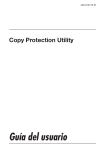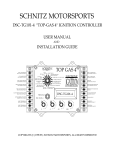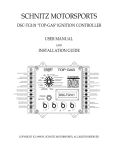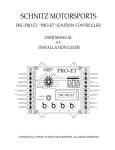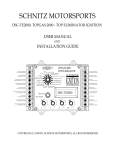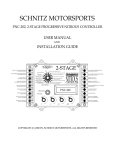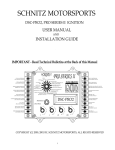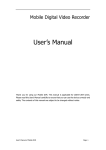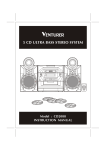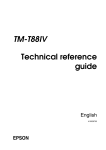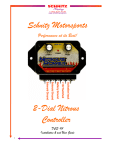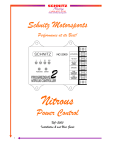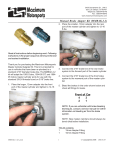Download 34-DSC-98PS - Star Racing
Transcript
SCHNITZ MOTORSPORTS DSC-98PS "PRO-STREET" IGNITION CONTROLLER USER MANUAL AND INSTALLATION GUIDE Pro Street SCHNITZ MOTORSPORTS SHIFT LIGHT POSITIVE PAGE 20 1 RUN or Volts HIGH SHIFT LIGHT GROUND PAGE 20 2 NOS SOLENOID GROUND 16GA ORANGE, PAGE 19 3 FUEL SOLENOID GROUND 16GA PURPLE, PAGE 19 4 NOS ACTIVATION INPUT 20GA BROWN, PAGE 19 5 CLUTCH SWITCH INPUT(2-STEP) 20GA YELLOW, PAGE 19 6 SHIFT COUNTER INPUT PAGE 19 7 ENGINE KILL #1 20GA GRAY, PAGE 18 8 ENGINE KILL #2 20GA GRAY, PAGE 18 9 SHIFT RPM 9 COIL 1,4 NEGATIVE 16GA WHITE, PAGE 18 ELECTRONIC 8 COIL 2,3 NEGATIVE 16GA BLUE, PAGE 18 IGNITION 7 GROUND 16GA BLACK, PAGE 18 6 +12 VOLT OUT 16GA RED, PAGE 19 5 +12 VOLT OUT 16GA RED, PAGE 18 4 +12 VOLT SWITCHED INPUT 16GA RED, PAGE 18 3 TACH OUTPUT 2 TRIGGER 2,3 20GA BLUE, PAGE 18 1 TRIGGER 1,4 20GA WHITE, PAGE 18 ENGINE RPM AND RPM DIAGNOSTICS LAUNCH RPM IGNITION BOOST RPM NOS SHIFT COUNTER NOS DELAY TIME IN SECONDS FULL TIMING NOS START PERCENT ADVANCE RPM DEGREES OF TIMING ADVANCE NOS FINAL PERCENT NOS BUILD TIME IN SECONDS SHIFT KILL TIME CONTROLLER REATRD BUILD TIME GNTITION TIMING RETARD DSC-98PS PROGRAM DSC-98PS 0 1 2 3 1 9 8 4 5 6 7 0 1 2 3 .1 9 8 4 5 6 7 0 1 2 3 .01 9 8 4 5 6 7 0 1 2 3 .001 9 8 4 5 6 7 COPYRIGHT (C) 1998 BY, SCHNITZ MOTORSPORTS, ALL RIGHTS RESERVED Important Application Information IMPORTANT Stock Crankshaft Trigger will NOT work with this Controller. Use only DYNA (S) ® or DYNA PRO SERIES ® Trigger. Use only a Dual Magnet Rotor for Crankshaft Trigger. Use only .7ohm High Energy (Blue) Ignition Coils. Part #DC9-1, DC9-2 Use only Static Suppression Spark-plug Wires. Part #DW-800 All items listed above are available from Schnitz Racing. 1-219-728-9730 Notice of Copyright Copyright (C) 1998 Schnitz Motorsports, Decatur, Indiana. All rights reserved. Copyright law protects this document. It is unlawful to make copies, modify, or distribute without written consent from Schnitz Motorsports. It is the responsibility of the purchaser to follow all guidelines and safety procedures supplied with this product and any other manufactures product used with this product. It is also the responsibility of the purchaser to determine compatibility of this device with the vehicle and other components. Schnitz Motorsports assumes no responsibility for damages resulting from accident, improper installation, misuse, abuse, improper operation, lack of reasonable care, or all previously stated reasons due to incompatibility with other manufacturer's products. Schnitz Motorsports assumes no responsibility or liability for damages incurred from the use of products manufactured or sold by Schnitz Motorsports on vehicles used for competition racing. Schnitz Motorsports neither recommends nor approves the use of products manufactured or sold by Schnitz Motorsports on vehicles which may be driven on public highways or roads, and assumes no responsibility for damages incurred from such use. It is the purchaser’s responsibility to check the state and local laws pertaining to the use of Nitrous Oxide for racing applications. Schnitz Motorsports does not recommend nor condone the use of its products for illegal street racing. Caution Follow all recommended safety guidelines from this and other manufacturer installation guidelines. Never install any device, which pulsates nitrous solenoids without a safety solenoid installed. Static suppression ignition wires must be used with this unit! Mount the Ignition Controller as far away from secondary ignition components (ignition coils, ignition wires, etc.) As is physically possible. Installation of Schnitz Motorsports products signifies that you have read this document and agree to the terms stated within. Page 2 Pro-Street Ignition Controller The Schnitz Motorsports Electronic Ignition Controller is an integrated ignition system. Key features of the device are as follows, high Energy output ignition with Programmable Ignition Timing Control. An Ignition Boost Mode is available and can be activated by a Programmable RPM setting or it is activated when the NOS is active. Built in Progressive Nitrous Controller with a Shift Counter to activate the Nitrous based on the gear position. A delay timer is also included for the Nitrous Activation. A Battery Voltage monitor. Other key features include a Digital Tachometer, Shift Light Output, Engine Kill Input and a Digital Tachometer compatible output. A 2-stage Rev-Limiter is also included. The Build Ignition Timing Retard is activated when the NOS Delay Timer has timed out and the NOS is turned on. This stage of retard has a range of 1 to 22 degrees of retard. This retards the timing progressively over time. The time span is adjustable from .2 to 9.9 seconds. NOTE: You cannot retard the timing more than the amount of Timing Advance that is programmed in the controller. The controller is compatible with DYNA(s) or DYNA PROSERIES (r) crankshaft triggers. .7 ohm DYNA(r) ignition coils are also required for operation. Never operate the controller without static suppression ignition wires or undesirable operation may result. The NOS solenoid output drivers have dedicated +12volt supply terminals for isolating electrical noise due to noise generated by the solenoids during operation. The controller drives the negative side of the NOS solenoids providing precise control. Once the NOS has been activated an internal timer is started and the NOS, retard system will reset 20 seconds after activation. During this activation period the settings cannot be changed. Also if the NOS is deactivated during operation the controller will wait at its present state and resume there when the NOS is re-activated. The ignition retard will continue to operate even when the NOS is de-activated. Page 3 Schnitz Motorsports DSC-PS98, Pro-Street Ignition Controller Table of Contents Important Information and Cautions Overview of Controller and Features Page 2 Page 3 Section 1, Setting Controller Parameters 1.0 – The Basics of Setting Controller Parameters 1.1 – Setting HIGH RPM, Upper RPM Limit 1.2 – Setting LAUNCH RPM 1.3 – Setting SHIFT LIGHT RPM 1.4 – Setting SHIFT KILL TIME for Air Shift Applications 1.5 – Setting IGNITION BOOST RPM 1.6 – Setting FULL TIMING ADVANCE RPM 1.7 – Setting DEGREES OF TIMING ADVANCE 1.8 – Setting IGNITION TIMING RETARD 1.9 – Setting IGNITION TIMING RETARD BUILD TIME 1.10 – Setting NOS SHIFT COUNTER 1.11 – Setting NOS DELAY TIME 1.12 – Setting NOS START PERCENT 1.13 – Setting NOS FINAL PERCENT 1.14 – Setting NOS BUILD TIME 1.15 – Checking Battery Voltage Page 5 Page 6 Page 6 Page 6 Page 7 Page 7 Page 8 Page 8 Page 9 Page 9 Page 9 Page 10 Page 10 Page 10 Page 11 Page 11 Section 2, Diagnostics 2.0 - Description of Diagnostic Functions 2.1 - Ignition Coil Output Test 2.2 - Setting Ignition Static Timing 2.3 - Additional Information about Static Timing the Ignition 2.4 - Testing NOS Activation Input 2.5 - Testing Clutch Switch Input (Launch RPM Control) 2.6 - Testing Engine Kill Input 2.7 - Testing NOS Shift Counter Input Page 12 Page 12 Page 12 Page 13 Page 14 Page 14 Page 14 Page 15 Section 3, Wiring Diagrams and Installation Instructions 3.0 - Overview of Installation Procedures 3.1 - Using an Electric Over Air Shift Solenoid 3.2 - Connecting the Ignition Components 3.3 - Connecting the Nitrous Oxide System 3.4 - Connecting the Shift Light and Optional Auto-Shift Page 16 Page 17 Page 18 Page 19 Page 20 Warranty Information 4.0 – Warranty Page 21 Trouble Shooting 5.0 - Common Problems and Solutions Page 4 Page 22 1.0 - The Basics of Setting Controller Parameters 1 - Select Switch Pro Street SCHNITZ MOTORSPORTS SHIFT LIGHT POSITIVE PAGE 20 1 SHIFT LIGHT GROUND PAGE 20 2 NOS SOLENOID GROUND PAGE 19 3 FUEL SOLENOID GROUND PAGE 19 4 NOS ACTIVATION INPUT PAGE 19 5 CLUTCH SWITCH INPUT(2-STEP) PAGE 19 6 SHIFT COUNTER INPUT PAGE 19 RUN or Volts HIGH SHIFT RPM RPM DIAGNOSTICS LAUNCH RPM IGNITION BOOST RPM NOS SHIFT COUNTER NOS DELAY TIME IN SECONDS FULL TIMING NOS START PERCENT ADVANCE RPM DEGREES OF TIMING ADVANCE NOS FINAL PERCENT NOS BUILD TIME IN SECONDS SHIFT KILL TIME ENGINE KILL #1 PAGE 18 ENGINE KILL #2 PAGE 18 9 COIL 1,4 NEGATIVE PAGE 18 ELECTRONIC 8 COIL 2,3 NEGATIVE PAGE 18 IGNITION 7 GROUND PAGE 18 6 +12 VOLT OUT PAGE 19 5 +12 VOLT OUT PAGE 18 4 +12 VOLT SWITCHED INPUT PAGE 18 3 TACH OUTPUT 2 TRIGGER 2,3 PAGE 18 1 TRIGGER 1,4 PAGE 18 CONTROLLER REATRD BUILD TIME GNTITION TIMING RETARD DSC-98PS PROGRAM 7 8 9 ENGINE RPM AND DSC-98PS 0 1 2 3 1 9 8 4 5 6 7 0 1 2 3 .1 9 8 0 1 2 3 4 5 6 7 .01 9 8 0 1 2 3 4 5 6 7 .001 9 8 4 5 6 7 2 - Programming Switch 3 - Data Switches Switch Descriptions and Functions 1 - Switch #1 is the FUNCTION SELECT SWITCH, This switch is used to select which parameter is displayed and also selects that parameter for programming. 2 - Switch #2 is the PROGRAM SWITCH, When this switch is pressed down and held for 2-seconds the DATA switches will be read and the settings will be programmed into the controller. If an INVALID setting is read the controller will NOT save the setting and will display an INVALID message on the display. 3 - Data Switches #3 are for entering RPM Data, Ignition Retard Data, NOS Control Data, and for selecting various options as described in the following pages. Example Programming Sequence Function Select Switch(#1) set to HIGH RPM (Switch pointing to HIGH RPM) Data Switch 1 set at 1, .01 at 2, .001 at 5, .001 at 0 Data Switch 1 x 10,000 RPM Data Switch .1 x 1,000 RPM Data Switch .01 x 100 RPM Data Switch .001 is Ignored Pressing and holding PROGRAM Switch for 2-seconds will set the HIGH RPM at 12,500 RPM. Please refer to each of the following sections for setting all Functions. Page 5 1.1– Setting HIGH RPM, Upper RPM Limit Set SELECT Switch to HIGH RPM. Example that would set HIGH RPM at 10,400 1 set at 1 .1 set at 0 .01 set at 4 .001 set at 0 Press PROGRAM Button until the display reads PROGRAM. Release the button and the display will now read 10,400. HIGH RPM is now set at 10,400 RPM. Valid RPM range 2,000 to 14,500 RPM in 100-RPM Increments. Setting HIGH RPM to 0 will turn this function off. 1.2- Setting LAUNCH RPM Set SELECT Switch to LAUNCH RPM. Example that would set LAUNCH RPM at 7,200 1 set at 0 .1 set at 7 .01 set at 2 .001 set at 0 Press PROGRAM Button until the display reads PROGRAM. Release the button and the display will now read 7,200. LAUNCH RPM is now set at 7,200 RPM. Valid RPM range 2,000 to 14,500 RPM in 100-RPM Increments. Setting LAUNCH RPM to 0 will turn this function off. 1.3 - Setting SHIFT LIGHT RPM Set SELECT Switch to SHIFT LIGHT RPM. Example that would set SHIFT LIGHT RPM at 9,800 1 set at 0 .1 set at 9 .01 set at 8 .001 set at 0 Press PROGRAM Button until the display reads PROGRAM. Release the button and the display will now read 9,800. SHIFT LIGHT RPM is now set at 9,800 RPM. Valid RPM range 2,000 to 14,500 RPM in 100-RPM Increments. Setting SHIFT LIGHT RPM to 0 will turn this function off. Page 6 1.4 – Setting SHIFT KILL TIME Set SELECT Switch to ENGINE KILL TIME Example that would set ENGINE KILL TIME at 85 milliseconds 1 set at .1 set at .01 set at .001 set at 0 0 8 5 Press the PROGRAM button until the display reads PROGRAM. Display will now read .085 and ENGINE KILL TIME is set at 85 milliseconds. Valid Time range .020 to .150 second in .001 increments. 1.5 – Setting IGNITION BOOST RPM Set SELECT Switch to IGNITION BOOST RPM Example that would set HIGH RPM at 10,400 1 set at 1 .1 set at 0 .01 set at 4 .001 set at 0 Press PROGRAM button until the display reads PROGRAM. Display will now read 10,400 and HIGH RPM is set at 10,400 RPM. Valid RPM range 2,000 to 14,500 RPM, 100-RPM Increments. Setting RPM to 0 will turn this function OFF. NOTE: When the Ignition is active it provides a 45% increase in ignition energy. The amperage draw will increase by approx. 50% when the ignition boost is on. Also, the boost is activated automatically when the NOS is activated. Page 7 1.6 – Setting FULL TIMING ADVANCE RPM Set SELECT Switch to FULL TIMING ADVANCE RPM Example that would set FULL TIMING ADVANCE at 3,400 RPM 1 set at 0 .1 set at 3 .01 set at 4 .001 set at 0 Press PROGRAM button until the display reads PROGRAM. Display will now read 3,400 and FULL TIMING ADVANCE RPM is set at 3,400 RPM. Valid RPM range 2,400 to 14,500 RPM, 100-RPM Increments. IMPORTANT INFORMATION: This setting is used along with DEGREES OF TIMING ADVANCE to adjust the Advance Curve for the ignition timing. The following information can be used to build almost any desired timing curve. CAUTION: Setting the Advance to High can Cause DETONATION which WILL HARM the engine. If you do not know where to set the ignition timing and advance setting then contact YOUR engine builder to obtain basic ignition timing information. NOTE: Ignition Advance will begin at 1,400 RPM. Formula to Determine Advance Curve: Advance RPM Range = Full Timing Advance RPM - 1,400 RPM for 1 Degree of Advance = Advance RPM Range/Degrees of Advance Degrees of Advance Per 1,000 RPM = 1000 / RPM for 1 Degree Example: FULL TIMING ADVANCE RPM = 3,800 ADVANCE BEGINING RPM = 1,400 DEGREES OF TIMING ADVANCE = 30 3,800 - 1,400 = 2,400 (Advance RPM Range) 2,400 / 32 = 80 (Every 80 RPM Increase will Advance Timing 1 Degree) 1000 / 80 = 12.5 (Ignition Timing will Advance 12.5 Degrees every 1,000 RPM) 1.7 – Setting DEGREES OF TIMING ADVANCE Set SELECT Switch to DEGREES OF TIMING ADVANCE Example that would set DEGREES OF TIMING ADVANCE to 22 degrees 1 set at 0 (not used) .1 set at 0 (not used) .01 set at 2 .001 set at 2 Press PROGRAM button until the display reads PROGRAM. Display will now read 22 DEG and DEGREES OF TIMING ADVANCE is set to 22 degrees. Valid range 0 to 34 Degrees, 1 degree Increments. Setting to 0 will turn this function OFF. CAUTION: Setting the Advance to High can Cause DETONATION which WILL HARM the engine. If you do not know where to set the ignition timing and advance setting then contact YOUR engine builder to obtain basic ignition timing information. Page 8 1.8 – Setting IGNITION TIMING RETARD Set SELECT Switch to IGNITION TIMING RETARD Example that would set IGNITION TIMING RETARD to 14 degrees 1 set at 0 (not used) .1 set at 0 (not used) .01 set at 1 .001 set at 4 Press PROGRAM button until the display reads PROGRAM. Display will now read 14 DEG and IGNITION TIMING RETARD is set to 14 degrees. Valid range 1 to 22 Degrees in 1 degree Increments. Setting to 0 will turn this function OFF. NOTE: This retard stage will turn on when the NOS Delay Timer has timed out and the NOS is turned on. The retard will progressively come on based on the IGNITION TIMING RETARD BUILD TIME setting. If the degrees of RETARD are greater than the degrees of ADVANCE then the timing will only be retarded to the STATIC timing position. 1.9 – Setting IGNITION TIMING RETARD BUILD TIME Set SELECT Switch to RETARD BUILD TIME IN SECONDS Example that would set RETARD BUILD TIME at 2.400 seconds 1 set at 2 .1 set at 4 .01 set at 0 (not used) .001 set at 0 (not used) Press PROGRAM button until the display reads PROGRAM. Display will now read 2.400 and RETARD BUILD TIME is set at 2.400 seconds. Valid Time Range .200 to 9.900 seconds, .1 second Increments. Note: This setting determines the Ramp of IGNITION TIMING RETARD. A low setting i.e. (.200) will make the TIMING RETARD very aggressive. A high setting i.e. (9.900) will make the TIMING RETARD gradual. 1.10 – Setting NOS SHIFT COUNTER Set SELECT Switch to NOS SHIFT COUNTER Example that would set NOS SHIFT COUNTER to 2nd Gear 1 set at 0 (not used) .1 set at 0(not used) .01 set at 0 (not used) .001 set at 1 Press PROGRAM button until the display reads PROGRAM. Display will now read Gear: 2 and NOS SHIFT COUNTER is set for 2nd Gear. Valid Shift Count Range: 0 to 5 Note: This setting is how many Shift Counts before the NOS is activated. If set to 0 then the NOS will come on without any Shift Counts Occurring. Also the DISPLAY would show Gear: 1 IMPORTANT: The Shift Counter increments 1 count for each 12volt pulse/signal that is applied to the SHIFT COUNTER INPUT. Page 9 1.11 – Setting NOS DELAY TIME Set SELECT Switch to NOS DELAY TIME IN SECONDS Example that would set NOS DELAY TIME at 1.250 seconds 1 set at 1 .1 set at 2 .01 set at 5 .001 set at 0 Press PROGRAM button until the display reads PROGRAM. Display will now read 1.250 and NOS DELAY TIME is set to 1.250 seconds. Valid range 0.000 to 9.999 seconds in .001 second increments. Note: This is timer to delay the start of NOS. A time of 0.000 will allow the NOS to start immediately when activated. 1.12 – Setting the NOS START PERCENT Set SELECT Switch to NOS START PERCENT Example that would set NOS START PERCENT at 34% 1 set at 0 (not used) .1 set at 0 .01 set at 3 .001 set at 4 Press PROGRAM button until the display reads PROGRAM. Display will now read 34% and NOS START PERCENT is set at 34%. Valid Percentage Range 20 to 100% in 1% increments. Note: This setting allows the starting POWER developed from the NOS to be controlled for traction and other reasons. 1.13 – Setting NOS FINAL PERCENT Set SELECT Switch to NOS FINAL PERCENT Example that would set NOS FINAL PERCENT at 100% 1 set at 0 (not used) .1 set at 1 .01 set at 0 .001 set at 0 Press PROGRAM button until the display reads PROGRAM. Display will now read 100% and NOS FINAL PERCENT is set at 100%. Valid Percentage Range 20 to 100%, 1% Increments. Note: This setting controls the maximum percentage of Nitrous Oxide that will be delivered to the engine. A setting of less than 100% can be used. However, if FINAL% is less than START% the NOS will remain at START% for the entire NOS cycle. Page 10 1.14 – Setting NOS BUILD TIME Set SELECT Switch to NOS BUILD TIME IN SECONDS Example that would set NOS BUILD TIME at 3.500 seconds 1 set at 3 .1 set at 5 .01 set at 0 (not used) .001 set at 0 (not used) Press PROGRAM button until the display reads PROGRAM. Display will now read 3.500 and NOS BUILD TIME is set at 3.500 seconds. Valid Time Range .200 to 9.900 seconds in .1 second Increments. Note: This setting determines how fast the NOS goes from START PERCENT to FINAL PERCENT. A shorter BUILD TIME will make the NOS Power Curve more Aggressive. 1.15 – Checking Battery Voltage Set SELECT Switch to VOLTS Battery Voltage will now be displayed. It is normal for the battery voltage reading to vary with the engine running. This is due to the short duration high current demands of the ignition coils. Page 11 Section 2, Diagnostics 2.0 – Description of Diagnostic Functions The Diagnostics Functions will allow the user to test the output of the ignition coils, static time the ignition system, and test the activation inputs. These functions are only available if NO crankshaft movement has occurred. If the engine is running or has been turned over the diagnostics functions cannot be accessed. When the engine is running this selection automatically displays engine RPM on the display. 2.1 – Ignition Coil Output Test Set the SELECT Switch to DIAGNOSTICS Press and HOLD the PROGRAM Switch until display reads RELEASE. Release the PROGRAM Switch at this time. The controller is now in the diagnostic mode. To perform an ignition coil output test set the .001 switch to 0. Press and release the PROGRAM switch. Each coil will be fired one time. Caution: The ignition coils will produce a high voltage spark. Use appropriate methods for testing. To exit diagnostics turn the .001 switch to 6. Then press and release the PROGRAM switch. 2.2 – Setting Ignition Static Timing Set the SELECT Switch to DIAGNOSTICS Press and HOLD the PROGRAM Switch until display reads RELEASE. Release the PROGRAM Switch at this time. The controller is now in the diagnostic mode. To set the Static Timing set the .001 switch to 1. The display will read one of the following messages. STATIC - This shows the controller is in Static Timing Mode FIRE 1,4 - This shows when 1,4 cylinder will fire. FIRE 2,3 - This shows when 2,3 cylinder will fire. Note: Never Static Time the engine from the first trigger magnet. Only use the second magnet 90 degrees past the first magnet. Rotate the engine in the same direction as when running. The firing point for the spark is at the point where the display changes to the message FIRE *, *. To exit diagnostics turn the .001 switch to 6. Then press and release the PROGRAM switch. IMPORTANT: This is the BASE TIMING for the ignition. If you do NOT understand this setting then contact YOUR engine builder for help. Page 12 2.3 - STATIC TIMING SHEET - SCHNITZ IGNITIONS *** IMPORTANT INFORMATION *** SETTING IGNITION STATIC TIMING 1 - INSTALL A DEGREE WHEEL AND LOCATE TOP DEAD CENTER AS OUTLINED WITH THE DEGREE WHEEL INSTRUCTIONS. IF YOU DO NOT HAVE A DEGREE WHEEL SCHNITZ RACING CARRIES THIS ITEM. THIS IS THE MOST ACCURATE WAY TO SET THE IGNITION TIMING. IF YOU DO NOT KNOW THE IGNITION TIMING SPECIFICATIONS FOR YOUR ENGINE, CONTACT YOUR ENGINE BUILDER FOR ASSISTANCE. 2 - ENTER DIAGNOSTIC MODE AS OUTLINED IN THE INSTRUCTION MANUAL. SET THE .001 DATA SWITCH TO 1, THIS IS THE STATIC TIMING MODE. IMPORTANT: NEVER SET IGNITION TIMING BY ANY OTHER METHOD THAN THAT WHICH IS OUTLINED BY THIS INSTRUCTION SHEET. 3 - AT THIS TIME THE DISPLAY SHOULD READ ONE OF THE FOLLOWING. STATIC - INDICATING STATIC TIMING MODE. FIRE 1,4 - THIS INDICATES #1,4 TRIGGER IS ACTIVE. FIRE 2,3 - THIS INDICATES #2,3 TRIGGER IS ACTIVE. TURN THE ENGINE THE DIRECTION OF NORMAL ROTATION. NOTE: THERE ARE 2 MAGNETS ON THE TRIGGER ROTOR. THE DISPLAY WILL INDICATE WHEN BOTH OF THESE MAGNETS ARE ALIGNED WITH THE TRIGGER. YOU MUST USE THE SECOND MAGNET, THE SECOND MAGNET IS THE ONE THAT FIRES THE IGNITION COIL. PLEASE NOTE THAT THE DISPLAY WILL INDICATE THE PRECISE TIME WHEN THE TRIGGER IS ACTIVATED BY THE ROTOR MAGNET. ADJUST THE TRIGGER PLATE OR TRIGGER ASSEMBLY TO OBTAIN THE CORRECT IGNITION TIMING. EXAMPLE SHOWING 1ST AND 2ND TIMING MAGNETS AT THIS TIME THE DISPLAY WOULD READ: FIRE 1,4 ROTATION #2,3 ROTOR 2ND 1ST TRIGGER PLATE ASSEMBLY Page 13 #1,4 2.4– Testing NOS Activation Input Set the SELECT Switch to DIAGNOSTICS Press and HOLD the PROGRAM Switch until display reads RELEASE. Release the PROGRAM Switch at this time. The controller is now in the diagnostic mode. To perform NOS Activation Input test set the .001 switch to 3. At this time the DISPLAY will read NOS. If +12 volts is connected to the NOS Activation terminal the Display will flash the message ACTIVE. Use this test to verify NOS arming/activation switches on the bike. To exit diagnostics turn the .001 switch to 6. Then press and release the PROGRAM switch. 2.5– Testing the Clutch Switch Input Set the SELECT Switch to DIAGNOSTICS Press and HOLD the PROGRAM Switch until display reads RELEASE. Release the PROGRAM Switch at this time. The controller is now in the diagnostic mode. To perform CLUTCH (2-step) Input test set the .001 switch to 2. At this time the DISPLAY will read CLUTCH. If +12 volts is connected to the CLUTCH input terminal the Display would flash the message ACTIVE. Use this test to verify clutch/2-step switches on the bike. To exit diagnostics turn the .001 switch to 6. Then press and release the PROGRAM switch. 2.6– Testing Engine Kill Input Set the SELECT Switch to DIAGNOSTICS Press and HOLD the PROGRAM Switch until display reads RELEASE. Release the PROGRAM Switch at this time. The controller is now in the diagnostic mode. To perform ENGINE KILL Input test set the .001 switch to 5. At this time the DISPLAY will read KILL. If +12 volts is connected to the ENGINE KILL terminal the Display will flash the message ACTIVE. Use this test to verify the ENGINE KILL activation switch. To exit diagnostics turn the .001 switch to 6. Then press and release the PROGRAM switch. Page 14 2.7– Testing Shift Counter Input Set the SELECT Switch to DIAGNOSTICS Press and HOLD the PROGRAM Switch until display reads RELEASE. Release the PROGRAM Switch at this time. The controller is now in the diagnostic mode. To perform SHIFT COUNTER Input test set the .001 switch to 4. At this time the DISPLAY will read COUNTER. If +12 volts is connected to the SHIFT COUNTER terminal the Display will flash the message ACTIVE. Use this test to verify the SHIFT COUNTER activation switch. To exit diagnostics turn the .001 switch to 6. Then press and release the PROGRAM switch. Page 15 Section 3, Wiring Diagrams and Installation Instructions 3.0 – Overview of Installation Instructions Please read and follow all instructions carefully. It is important that the installation guidelines be followed for maximum performance. Guidelines: 1 - If Stock Ignition Switch is used a SEPARATE POWER SOURCE for the NOS System is HIGHLY recommended. Please refer to page 17. 2 - Use a good quality wire of recommended size. 3 - Solder all connectors to the wire, crimped connectors fail! 4 - Use shrink wrap to protect exposed terminals/wires. 5 - Install the proper FUSE where required. 6 - Use only the recommended ignition components. 7 - Use quality switches. 8 - Follow other manufacturer guidelines and recommendations when installing related components. 9 - NEVER disregard SAFETY and/or CAUTION Warnings! 10 - Mount all components correctly. Related Components Needed for Installation and Operation 1 - Ignition Coils, DYNA (r) .7 ohm blue coils. 2 - Static Suppression Ignition Wires ONLY! 3 - Crankshaft Trigger, DYNA (s) or PRO SERIES (r) (DUAL magnet rotor ONLY!) 4 - Nitrous System, Recommended NOS Kit (optional). (Use genuine NOS components for best results) 5 - Activation switches as needed. 6 - Electric over air shift components (optional). Components listed as optional may be used or NOT used, this is at the users/installers desecration. Page 16 3.1 - NOISE SUPPRESSION DIODE INSTALLATION FOR ELECTRIC OVER AIR SHIFT SOLENOIDS Installation Instructions for SCHNITZ IGNITION CONTROLLERS with AUTO-SHIFT. 1 - PRO-STREET, Connect this way ONLY if the Shift Light Output is being used for Auto-Shifting. a - Red Wire to LEFT #1 Terminal, Shift Light Positive b - Black Wire to Left #2 Terminal, Shift Light Ground 2 - TOP-GAS a - Red Wire to LEFT #2 Terminal, Shift Output b - Black Wire to RIGHT #7 Terminal, Ground 3 - TOP-GAS "4" a - Red Wire to RIGHT #4 Terminal, Switched +12 Volts b - Black Wire to LEFT #4 Terminal, Shift Solenoid Ground Installation Instructions for All SCHNITZ AUTO-SHIFTER's 1 - Connect the Noise Suppression Diode RED WIRE to the AUTO-SHIFT Red Wire that is going to the Shift Solenoid. 2 - Connect the Noise Suppression Diode BLACK WIRE to the AUTO-SHIFT Blue Wire. Installation Instructions for all MANUAL SHIFT Electric Over Air Shifter, PRO-MOD & FUNNY-BIKE 1 - Red Wire to Positive(+!2V side) Shift Solenoid Wire. 2 - Black Wire to Shift Solenoid Ground Wire. The Noise Suppression Diode should be placed within 6 inches of the Shift Solenoid. The recommended method for connecting the Diode is as follows. 1 - Strip the Insulation off from the Shift Solenoid wires approx. 6 inches back. 2 - Remove the Spade Terminals from the Diode Wires and remove approx. 1/2 inche of insulation. 3 - Wrap the Diode RED WIRE around the Shift Solenoid Positive Wire. 4 - Wrap the Diode BLACK WIRE around the Shift Solenoid Ground Wire. 5 - SOLDER these Connections, These connections will fail if they are NOT soldered. 6 - Cover the connections with Shrink Wrap or Electrical Tape. 7 - Test Shift Solenoid Operation. If the Solenoid will Operate the DIODE is most likely installed backwards e.g.(Red and Black wires reversed). RED WIRE Example Installation DIODE SHIFT SOLENOID To Shifter Arming Switch(+12V) Shift Switch Page 17 BLACK WIRE Ground 3.2 - Connecting the Ignition Components Pro Street SCHNITZ MOTORSPORTS SHIFT LIGHT POSITIVE PAGE 20 1 RUN or Volts SHIFT RPM HIGH SHIFT LIGHT GROUND PAGE 20 2 NOS SOLENOID GROUND PAGE 19 3 FUEL SOLENOID GROUND PAGE 19 4 NOS ACTIVATION INPUT PAGE 19 5 CLUTCH SWITCH INPUT(2-STEP) PAGE 19 6 SHIFT COUNTER INPUT PAGE 19 7 ENGINE KILL #1 8 COIL 1,4 NEGATIVE DIAGNOSTICS LAUNCH RPM IGNITION BOOST RPM NOS SHIFT COUNTER NOS DELAY TIME IN SECONDS ELECTRONIC 8 COIL 2,3 NEGATIVE FULL TIMING NOS START PERCENT ADVANCE RPM IGNITION 7 GROUND DEGREES OF TIMING ADVANCE NOS FINAL PERCENT NOS BUILD TIME IN SECONDS SHIFT KILL TIME 6 +12 VOLT OUT PAGE 19 5 +12 VOLT OUT 4 +12 VOLT SWITCHED INPUT 3 TACH OUTPUT 2 TRIGGER 2,3 1 TRIGGER 1,4 CONTROLLER REATRD BUILD TIME GNTITION TIMING RETARD DSC-98PS PROGRAM DSC-98PS 0 1 2 3 9 1 9 8 0 1 2 3 4 5 6 7 .1 9 8 4 5 6 7 0 1 2 3 9 8 .01 0 1 2 3 4 5 6 7 9 8 .001 4 5 6 7 LEFT RIGHT GROUND, BLACK 16 GA ENGINE KILL #2 9 ENGINE RPM AND RPM IMPORTANT - CHECK VOLTAGE AT CONTROLLER WHILE STARTING ENGINE. IF VOLTAGE IS LOW A SEPERATE POWER FEED FOR THE IGNITION COILS SHOULD BE USED. CAUTION - STOCK WIRING HARNESS MAY NOT PROVIDE ENOUGH VOLTAGE TO THIS IGNITION SYSTEM. CHECK VOLTAGE TO IGNITION IF ENGINE WILL NOT START. RED WIRE, 16GA, +12V FROM IGNITION SWITCH TRIGGER 1,4 WHITE 20GA TRIGGER 2,3 BLUE 20GA 16 GA FUSE 20A TO BATTERY + TERMINAL 16 GA T2 T4 T1 T3 DYNA S (R) BLACK TO TERMINAL #8 THIS ELIMINATES THE MICRO-SWITCH WHITE OPTIONAL ENGINE KILL, SHIFT WIRING MUST USE NOISE SUPPRESION DIODE! SEE PAGE 17 ELECTRIC OVER AIR SHIFT BUTTON SWITCH USE A HIGH QAULITY SNAP ACTION SWITCH MPS PRO-BUTTON SWITCH RECCOMENDED RED POS+ NEG 12 VOLT BATTERY NOTE: WIRING FOR PRO SERIES(R) PICKUP T1 - RED (+12V SWITCHED) T2 - BLACK (PICKUP GND) T3 - WHITE (TRIGGER 1,4) T4 - BLUE (TRIGGER 2,3) ENGINE GROUND +12 VOLTS COIL POSITIVE, RED 16 GA #2,3 COIL .7 OHM BLUE COIL #1,4 COIL .7 OHM BLUE COIL SHIFT GROUND SOLENOID Page 18 COIL 2,3 NEGATIVE TERMINAL, BLUE 16 GA OPTIONAL SHIFT SOLENOID ARMING SWITCH AIR KILL MICRO SWITCH COIL 1,4 NEGATIVE TERMINAL, WHITE 16 GA PICKUP GROUND BLACK. 20GA IGNITION SWITCH 3.3 - Connecting the Nitrous Oxide System NOTICE: ALL DIODES, CAPACITORS, AND FILTERS FROM PREVIOUS NOS INSTALLATIONS MUST BE REMOVED! FAILURE TO DO SO WILL RESULT IN UNDISIRABLE OPERATION OF THIS CONTROLLER. NOTE: NOS TIMERS WILL NOT BEGIN UNTIL 2-STEP IS OFF. THIS ALLOWS THE SYSTEM TO OPERATE WITHOUT RELAYS. THE NOS ACTIVATE INPUT IS IGNORED AS LONG AS THE CLUTCH INPUT IS ACTIVE. THE NOS SHIFT COUNTER WILL DELAY THE START OF THE NITROUS TIMERS IF IT IS SET TO ANY GEAR OTHER THAN 1ST. PLEASE SEE NOTE AT BOTTOM OF PAGE ON SHIFT COUNTER. Pro Street SCHNITZ MOTORSPORTS SHIFT LIGHT POSITIVE PAGE 20 1 RUN or Volts SHIFT RPM HIGH SHIFT LIGHT GROUND PAGE 20 2 NOS SOLENOID GROUND 3 FUEL SOLENOID GROUND 4 5 CLUTCH SWITCH INPUT(2-STEP) 6 LAUNCH RPM IGNITION BOOST RPM NOS SHIFT COUNTER NOS DELAY TIME IN SECONDS FULL TIMING NOS START PERCENT ADVANCE RPM DEGREES OF TIMING ADVANCE NOS FINAL PERCENT NOS BUILD TIME IN SECONDS 7 ENGINE KILL #1 PAGE 18 8 ENGINE KILL #2 PAGE 18 9 IGNITION CONTROLLER REATRD BUILD TIME GNTITION TIMING RETARD DSC-98PS PROGRAM SHIFT COUNTER INPUT ELECTRONIC DIAGNOSTICS SHIFT KILL TIME NOS ACTIVATION INPUT DSC-98PS 0 1 2 3 1 9 8 4 5 6 7 0 1 2 3 .1 9 8 4 5 6 7 0 1 2 3 .01 9 8 4 5 6 7 0 1 2 3 .001 9 8 4 5 6 7 CLUTCH SWITCH INPUT(S-STEP), YELLOW 20 GA NOS ACTIVATION INPUT, BROWN 20 GA NOS SOLENOID GROUND, 16 GA ORANGE NOS FUEL SOLENOID GROUND, 16 GA PURPLE LEFT SHIFT COUNTER ARMING SWITCH 9 COIL 1,4 NEGATIVE PAGE 18 8 COIL 2,3 NEGATIVE PAGE 18 7 GROUND PAGE 18 6 +12 VOLT OUT 5 +12 VOLT OUT PAGE 18 4 +12 VOLT SWITCHED INPUT PAGE 18 3 TACH OUTPUT 2 TRIGGER 2,3 PAGE 18 1 TRIGGER 1,4 PAGE 18 ENGINE RPM AND RPM RIGHT RED 16 GA - THIS MAY CONNECTED TO SEPERATE +12V SUPPLY USE A SEPERATE POWER SOURCE IF STOCK IGNITION SWITCH IS USED. FUSE 20A TO NOS FUEL PUMP NOS ARMING SWITCH 2-STEP BUTTON PART # SCH0070 THROTTLE ACTIVATED MICROSWITCH SWITCH ON ONLY WHEN THROTTLE IS WIDE OPEN. CONNECT TO ENGINE KILL #1 BY CONNECTING THE SHIFT COUNTER TO THE ENGINE KILL #1 TERMINAL EACH TIME AN ENGINE KILL IS ACTIVATED THE SHIFT COUNTER WILL INCREMENT ONE. THIS ALLOWS THE USER TO DETERMINE WHICH GEAR THE NITROUS TIMERS WILL BEGIN. ALL PRO-STREET CONTROLLERS AFTER #PS170 ARE PROGRAMMED SO THAT THE SHIFT COUNTER AND NOS TIMERS CAN BE TESTED WITHOUT THE ENGINE RUNNING. NOTE - SHIFT COUNTING WILL NOT BEGIN UNTIL NOS IS ACTIVTED PS170 AND LATER. EARLIER #'S WILL NOT COUNT SHIFTS UNLESS ENGINE IS RUNNING. LATER VERSION SOFTWARE IS AVAILABLE TO UPDATE. CALL SCHNITZ RACING FOR PRICE AND AVAILABILITY. NOS SOLENOID FUEL SOLENOID SAFETY SOLENOID GROUND Page 19 3.4 - Connecting the Shift Light and Optional Auto-Shift Pro Street SCHNITZ MOTORSPORTS SHIFT LIGHT POSITIVE 1 RUN or Volts SHIFT RPM HIGH SHIFT LIGHT GROUND 2 NOS SOLENOID GROUND PAGE 19 3 FUEL SOLENOID GROUND PAGE 19 4 NOS ACTIVATION INPUT PAGE 19 5 CLUTCH SWITCH INPUT PAGE 19 6 SHIFT COUNTER INPUT PAGE 19 7 ENGINE KILL #1 PAGE 18 8 ENGINE KILL #2 PAGE 18 9 9 COIL 1,4 NEGATIVE PAGE 18 ELECTRONIC 8 COIL 2,3 NEGATIVE PAGE 18 IGNITION 7 GROUND PAGE 18 6 +12 VOLT OUT PAGE 19 5 +12 VOLT OUT PAGE 18 4 +12 VOLT SWITCHED INPUT PAGE 18 3 TACH OUTPUT 2 TRIGGER 2,3 PAGE 18 1 TRIGGER 1,4 PAGE 18 ENGINE RPM AND RPM DIAGNOSTICS LAUNCH RPM IGNITION BOOST RPM NOS SHIFT COUNTER NOS DELAY TIME IN SECONDS FULL TIMING NOS START PERCENT ADVANCE RPM DEGREES OF TIMING ADVANCE NOS FINAL PERCENT NOS BUILD TIME IN SECONDS SHIFT KILL TIME CONTROLLER REATRD BUILD TIME GNTITION TIMING RETARD DSC-98PS PROGRAM DSC-98PS 0 1 2 3 1 9 8 4 5 6 7 0 1 2 3 .1 9 8 0 1 2 3 4 5 6 7 .01 9 8 0 1 2 3 4 5 6 7 .001 9 8 4 5 6 7 NOTE: NO ADDTIONAL RPM MODULE IS NEED FOR SHIFT LIGHT OPERATION. SHIFT LIGHT POSITIVE OUTPUT WILL PROVIDE +12VOLTS WHEN SHIFT RPM IS REACHED. THIS OUTPUT WILL SUPPLY UP TO 2 AMPS OF CURRENT. SHIFT LIGHT NEGATIVE, 20 WIRE SHIFT LIGHT POSITIVE, 20 GA WIRE CONNECT TO SHIFT LIGHT WIRES OR OPTIONAL AUTO-SHIFT AS OUTLINED BELOW. NEVER USE AS AUTO-SHIFT WITHOUT AN ARMING SWITCH. THIS CONFIGURATION IS FOR RACING USE ONLY AND IS NOT INTENDED FOR STREET USE. AUTO SHIFT ARMING SWITCH SHIFT BUTTON(SWITCH) +12 VOLTS FROM ARMING SWITCH OR IGNITION SWITCH CONNECT TO ENGINE KILL #1 IMPORTANT - MUST USE NOISE SUPPRESION DIODE WITH SHIFT SOLENOID. SEE PAGE 17 FOR DETAILED INSTRUCTIONS. Page 18 SHIFT SOLENOID GROUND Warranty Information 4.0 – Warranty Schnitz Motorsports warrants to the original purchaser that the Electronic Ignition Controller shall be free from defects in parts and workmanship under normal use for 90 days from the date of purchase. Schnitz Motorsports obligation under this warranty is limited to the repair or replacement of any component found to be defective when returned postpaid to Schnitz Motorsports. The Controller must be returned with evidence of place and date of purchase or warranty will be void. The warranty will not apply if the Electronic Ignition Controller has been installed incorrectly, repaired, damaged, or tampered with by misuse, negligence or accident. Phone 1-219-728-9457 Page 21 5.0 - Trouble Shooting IMPORTANT INSTALLATION INFORMATION 1 - TESTING FOR CORRECT BATTERY VOLTAGE WHEN USING STOCK/FACTORY WIRING HARNESS OR ANY OTHER QUESTIONABLE WIRING HARNESS. A - After installing the Electronic Ignition Controller test the Battery Voltage using the Controller Voltage Function. If battery voltage is LOW then test the Battery with a Volt Meter to insure correct voltage (12.0 Volts or Above). B - If a LOW voltage condition is present at the Controller but the Battery Voltage is 12.0 volts or above the Stock wiring is suspect. This is due to corrosion on connectors and in the wiring itself. This is common with older motorcycles. If this problem is NOT Corrected a NO START condition will exist!, also the amount of Ignition Energy produced will be LOW. C - If the Low Voltage condition exists you MUST install a new Power Feed and switch for the Ignition Controller and Coils. It is recommended that the entire wiring harness be replaced for maximum performance and reliability. 2 - NO START AND CONTROLLER HAS CORRECT VOLTAGE. A - View the Controller Voltage while Cranking the Engine to Start. If Low voltage is present the Current Draw of the starter should be checked. Also inspect the positive and negative battery cables for corrosion and split wires. If the Controller Turns OFF then back ON while cranking engine, Voltage is dropping while the starter is engaged. Check the Voltage at the Battery terminals to verify a good or large enough Battery is present. Voltage Should never drop below 10.0 Volts when engine is cranking and 12.1 Volts when running. 3 - AVOIDING PROBLEMS DUE TO INCORRECT GROUND WIRE CONNECTIONS. A - Digital Electronic Controllers require good Electrical Grounding Techniques. This is how the wires are Connected to the Ignition Controller, Solenoids, Engine, and Battery NOT the SIZE or CONDITION of the wires! 1 - Always connect the Ignition Controller Ground wire Directly to the Battery Negative Terminal. This is VERY IMPORTANT! 2 - Run ONE and ONLY ONE Ground wire to the Engine Case or Frame. 3 - Unless a Ground Terminal is provided for a Solenoid or Light on the Controller Connect it Directly to the Battery Negative Terminal. 4 - Always Install a ground wire from the Controller Ground Terminal to the Crankshaft Trigger. 5 - A Common Grounding Method is STAR POINT GROUNDING, This refers to connecting all Ground Wires to ONE COMMON POINT (Battery Negative Terminal). This is the most common and reliable Method of Connecting the Ground Wires for Digital Systems. 6 - When using the Proper Grounding Methods Electrical Noise problems are reduced or eliminated entirely. 4 - AVOIDING POSITIVE VOLTAGE INTERFERENCE PROBLEMS. A - If using an Electric Over Air Shift Solenoid a Noise Suppression Diode MUST be used. Detailed instructions are included in the Installation Section of the Controller Manual. Page 22






















